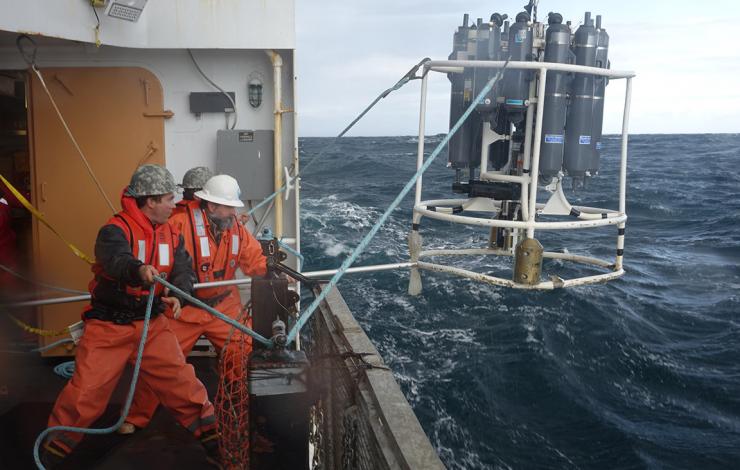Van Pelt, T.I., J.M. Napp, C.J. Ashjan, H.R. Harvey, M.W. Lomas, M.F. Sigler, and P.J. Stabeno (2016): An introduction and overview of the Bering Sea Project: Volume IV. Deep-Sea Res. II, 134, 3–12, doi:10.1016/j.dsr2.2016.09.002.
“…the National Science Foundation (NSF) and the North Pacific Research Board (NPRB) created a novel partnership in 2007 to support an ecosystem-scale study to examine how a changing climate and changing sea-ice conditions affect the EBS ecosystem, from physics and chemistry to lower trophic level organisms (e.g., plankton) to humans. The “Bering Sea Project” integrated two major research programs, the NSF-funded Bering Ecosystem Study (BEST) and the NPRB-funded Bering Sea Integrated Ecosystem Research Program (BSIERP), and was underpinned by substantial in-kind contributions from the National Oceanic and Atmospheric Administration (NOAA) and additional contributions from other agencies, universities, and institutions. The Bering Sea Project brought together nearly 100 principal investigators, leading a sprawling team of several hundred postdocs, graduate students, technicians, ship officers and crew, and many others. Over its seven-year course of activity (2007–2014, with primary field work taking place during 2008–2010), the Bering Sea Project has provided new insights into the functioning of the EBS ecosystem, particularly in the north-central region (~59°–~62°N) where data sets and temporal coverage previously had been sparse.
Since the final full-project meeting in early 2014, Bering Sea Project participants have focused on discussion, collaboration, data analysis, and publications, culminating in nearly 200 peer-reviewed Bering Sea Project papers to date published across a broad spectrum of journals. This growing publication library includes 76 papers in the previous three Bering Sea Project special issues in Deep-Sea Research II: Volumes 65–70 published in 2012, volume 94 published in 2013, and volume 109 published in 2014.”
Excerpt from: Van Pelt, T.I., J.M. Napp, C.J. Ashjan, H.R. Harvey, M.W. Lomas, M.F. Sigler, and P.J. Stabeno (2016): An introduction and overview of the Bering Sea Project: Volume IV. Deep-Sea Res. II, 134, 3–12, doi:10.1016/j.dsr2.2016.09.002.
This fourth and final special Bering Sea Project issue of Deep-Sea Research Part II builds upon work presented in the first three special issues, focusing on synthesis of information across broader ranges of disciplines, and presents information on some of the extensive model-based research directions within the project. The issue includes the following list of articles authored or coauthored by PMEL scientists:
Cheng, W., E. Curchitser, C Stock, A. Hermann, E.D. Cokelet, C. Mordy, P.J. Stabeno, G. Hervieux, and F. Castruccio (2016): What processes contribute to the spring and fall bloom co-variability on the eastern Bering Sea shelf? Deep-Sea Res. II, 134, 128–140, doi:10.1016/j.dsr2.2015.07.009.
Cokelet, E.D. (2016): 3-D water properties and geostrophic circulation on the eastern Bering Sea shelf. Deep-Sea Res. II, 134, 65–85, doi:10.1016/j.dsr2.2016.08.009.
Eisner, L.B., J.C. Gann, C. Ladd, and K. Cieciel (2016): Late summer/early fall phytoplankton biomass (chlorophyll a) in the eastern Bering Sea: Spatial and temporal variations and factors affecting chlorophyll a concentrations. Deep-Sea Res. II, 134, 100–114, doi:10.1016/j.dsr2.2015.07.012.
Gann, J.C., L.B. Eisner, S. Porter, J.T. Watson, K.D. Cieciel, C.W. Mordy, E.M. Yasumiishi, P.J. Stabeno, C. Ladd, R.A. Heintz, and E.V. Farley (2016): Possible mechanism linking ocean conditions to low body weight and poor recruitment of age-0 walleye pollock (Gadus chalcogrammus) in the southeast Bering Sea during 2007. Deep-Sea Res. II, 134, 115–127, doi:10.1016/j.dsr2.2015.07.010.
Hermann, A.J., G.A. Gibson, N.A. Bond, E.N. Curchitser, K. Hedstrom, W. Cheng, M. Wang, E.D. Cokelet, and P.J. Stabeno (2016): Projected future biophysical states of the Bering Sea. Deep-Sea Res. II, 134, 30–47, doi:10.1016/j.dsr2.2015.11.001.
Liu, C.L., L. Zhai, S.I. Zeeman, L.B. Eisner, J.C. Gann, C.W. Mordy, S.B. Moran, and M.W. Lomas (2016): Seasonal and geographic variations in modeled primary production and phytoplankton losses from the mixed layer between warm and cold years on the eastern Bering Sea shelf. Deep-Sea Res. II, 134, 141–156, doi:10.1016/j.dsr2.2016.07.008.
Ortiz, I., K. Aydin, A.J. Hermann, G.A. Gibson, A.E. Punt, F.K. Wiese, L.B. Eisner, N. Ferm, T.W. Buckley, E.A. Moffitt, J.N. Ianelli, J. Murphy, M. Dalton, W. Cheng, M. Wang, K. Hedstrom, N.A. Bond, E.N. Curchitser, and C. Boyd (2016): Climate to fish: Synthesizing field work, data and models in a 39-year retrospective analysis of seasonal processes in the eastern Bering Sea shelf and slope. Deep-Sea Res. II, 134, 390–412, doi:10.1016/j.dsr2.2016.07.009.
Sigler, M.F., J.M. Napp, P.J. Stabeno, R.A. Heintz, M.W. Lomas, and G.L. Hunt, Jr. (2016): Variation in annual production of copepods, euphausiids, and juvenile walleye pollock in the southeastern Bering Sea. Deep-Sea Res. II, 134, 223–234, doi:10.1016/j.dsr2.2016.01.003.
Stabeno, P.J., S. Danielson, D. Kachel, N.B. Kachel, and C.W. Mordy (2016): Currents and transport on the eastern Bering Sea shelf: An integration of over 20 years of data. Deep-Sea Res. II, 134, 13–29, doi:10.1016/j.dsr2.2016.05.010.



